What Does It Mean If My Dog Is Breathing Fast?
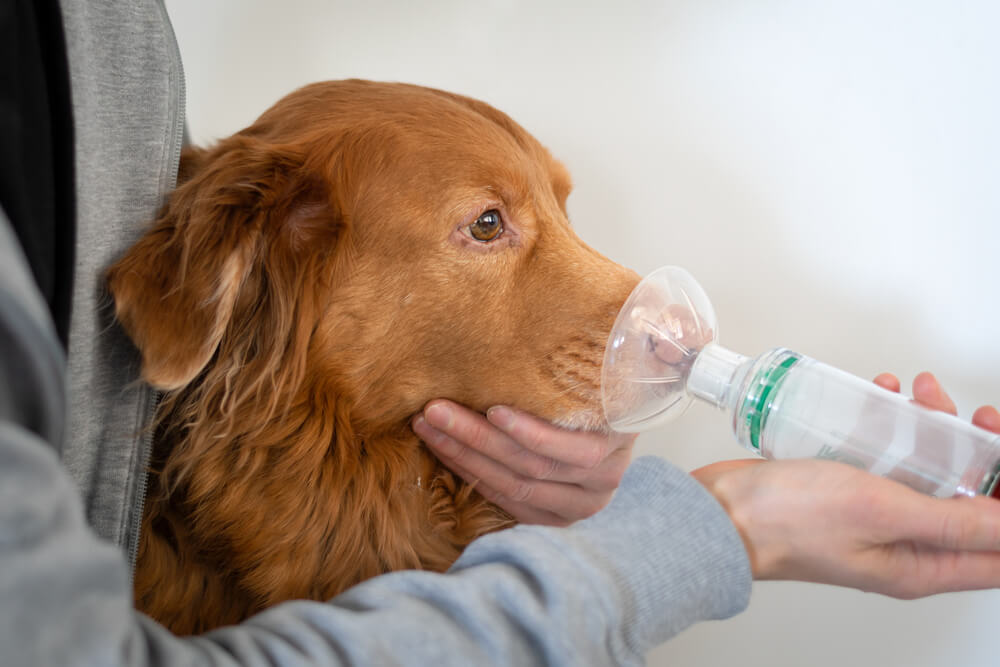
Table of Contents
Listen To The Article
Introduction to What Does It Mean If My Dog Is Breathing Fast?
When your dog’s breathing rate increases, you may wonder whether she’s anxious or excited or something else.
In fact, there are a lot of reasons why your dog might breathe faster than normal, and you can’t necessarily blame yourself for her increased breathing rate.
When your dog breathes fast, you may worry that something is wrong.
Perhaps your dog is in pain, or maybe he has some kind of disease.
But if your pooch is just panting, why does he do it? Does all of that panting mean your dog is breathing incorrectly? The answer is no.
A dog’s normal resting breathing rate is 12 to 20 breaths per minute.
When your dog breathes quickly, it may mean he is not feeling well. It could be a sign of a serious problem.
If your dog is breathing fast for no reason, this is a sign that something is wrong.
Try to stay calm, and keep reading to find out how to tell if you’re dealing with a serious problem or simply a harmless temporary issue.
However, it’s important to learn what may be causing this common symptom and whether you need to go see the vet.
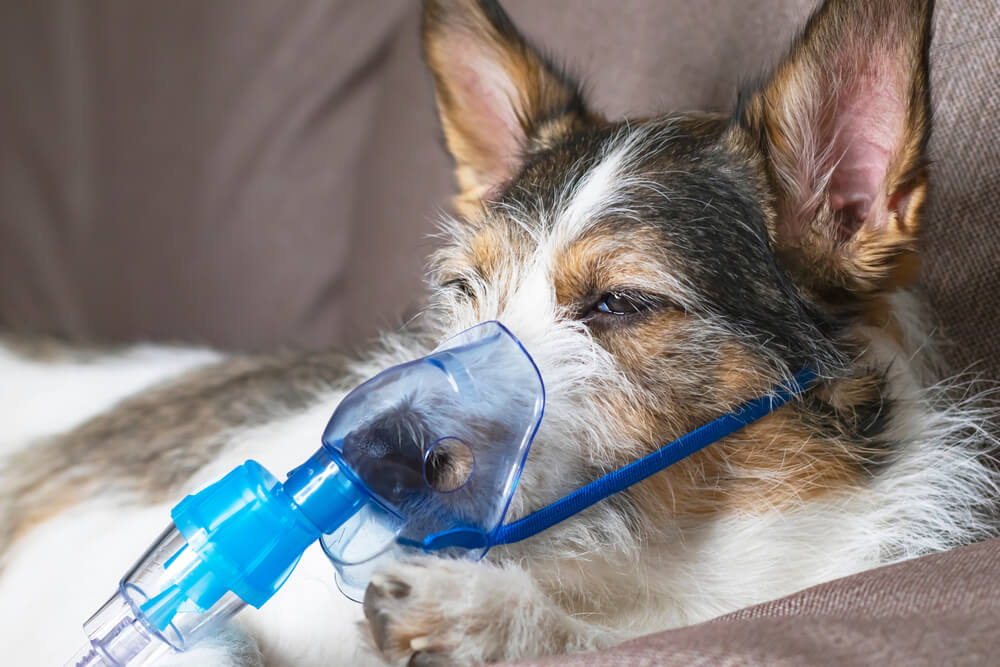
Is Your Dog Breathing Fast?
lists the dog’s normal respiratory rate as 18 – 34 breaths per minute at rest.
To sort out what’s normal and what’s not, count your dog’s respiratory rate while at rest or asleep.
While it’s normal to pant after exercise, some signs may indicate your dog is having trouble breathing or experiencing respiratory distress.
Examples include:
- Open-mouthed breathing
- Gums that are pale, brick red, or blue-tinged
- Drooling
- Using the tummy muscles to assist breathing
- Reluctance to eat, drink or move
Regardless of the cause, these are all signs your best buddy needs to see a vet.
The vet will examine the dog to work out where the problem lies; such as the head and neck, airway and lungs, heart and circulation, or a general health condition.
If you notice your dog breathing fast but acting normal with no other symptoms, you may decide to observe him for a few days and keep track of this respiratory rate to see if his rate returns to normal.
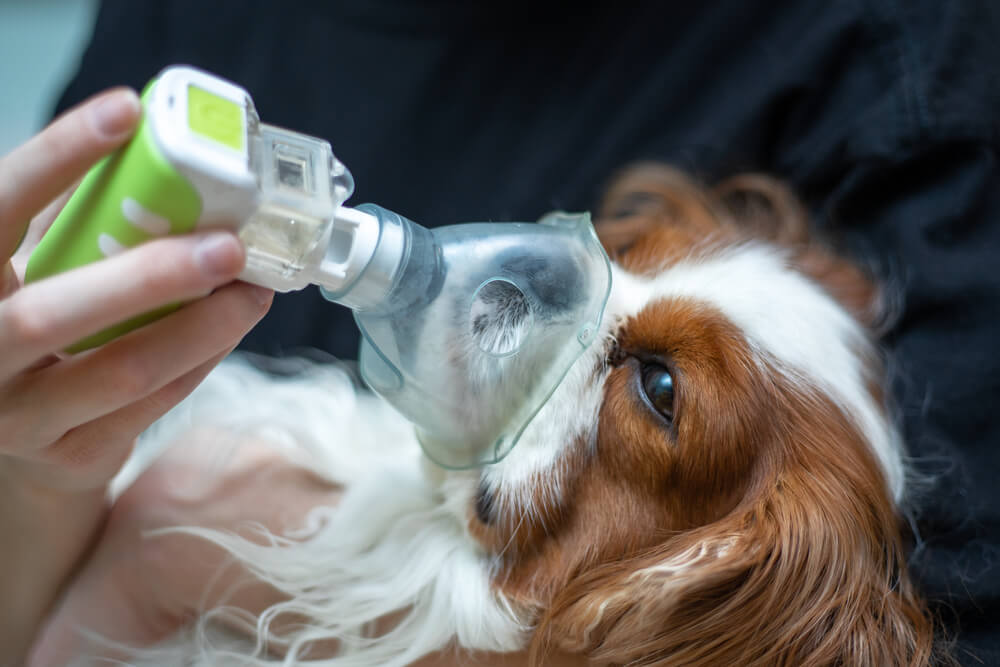
Squish-Faced Breeds
As adorable as Pugs, pekes, bulldogs, and Boston Terriers are, panting and breathing heavily through the nose is normal for these flat-faced breeds.
- Narrow nostrils
- A long, soft palate
- An outsized tongue
- Large tonsils
The canny Pug parent knows what’s normal for their dog and is alert for changes such as unusual drooling, refusal to move, or blue gums.
If your canine pal starts struggling, keep him cool and carry him home.
If he isn’t wolfing down treats within a few minutes, seek urgent veterinary attention.
It’s also good to know that it’s common for owners of flat-faced (brachycephalic) breeds to see their dog breathe fast through the nose while sleeping.
Rhinitis
A snotty nose makes it difficult to breathe.
However, rather than a head cold, most fur friends suffer from a long-term bacterial (or occasionally fungal) infection in the nasal chambers called rhinitis.
Rhinitis is more of an inconvenience than it is life-threatening. However, prompt treatment at the first signs of this infection can nip it in the bud and prevent it from dragging on.
The first signs of rhinitis are a sniffle and a drippy nose.
Clues include sneezing or the dog licking his nose more frequently as he uses his tongue as a handkerchief.
Windpipe (Trachea) Problems
Just as standing on a hose stops water flowing, anything that squashes the windpipe (trachea) makes it difficult to breathe.
A simple example is a dog that pulls on his collar, half-choking himself. In this case, rapid breathing is a sign the dog is struggling.
It’s important not to overexert the dog and to seek veterinary attention.
With the exception of kennel cough, these conditions are slow-burners that get worse over time.
Laryngeal Paralysis
Laryngeal paralysis is when the larynx (the entrance to the windpipe) doesn’t open fully which limits the amount of air reaching the lungs.
Pressure on the Windpipe
This can be due to an enlarged lymph node, a tumor in the throat, or an abscess pressing on the trachea.
Alternatively, this is your friendly dog pulling on his choke chain.
Pet owners are alert for subtle signs your dog is unwell, such as an inability to bark, reduced appetite, or drinking more than usual.
Lumps can be hard to find, so a vet checkup is advisable.
However, if you notice that your dog likes to pull on his chain, use a harness instead of a collar, and this simple change may resolve the issue.
Collapsing Trachea
Collapsing the trachea is when the windpipe isn’t rigid enough and each breath the dog takes sucks the windpipe flat.
Breeds such as the Chihuahua, Yorkshire Terrier, and the poodle is prone to this problem.
Kennel Cough
Kennel cough is a bacterial or viral infection that irritates the airway and makes it overly sensitive.
Kennel cough has a variety of symptoms and is highly contagious.
If the cough is mild, antibiotics are not necessary, and limiting walks is all that’s needed.
Avoid other dogs as he is contagious.
You can expect the symptoms to last two to four weeks.
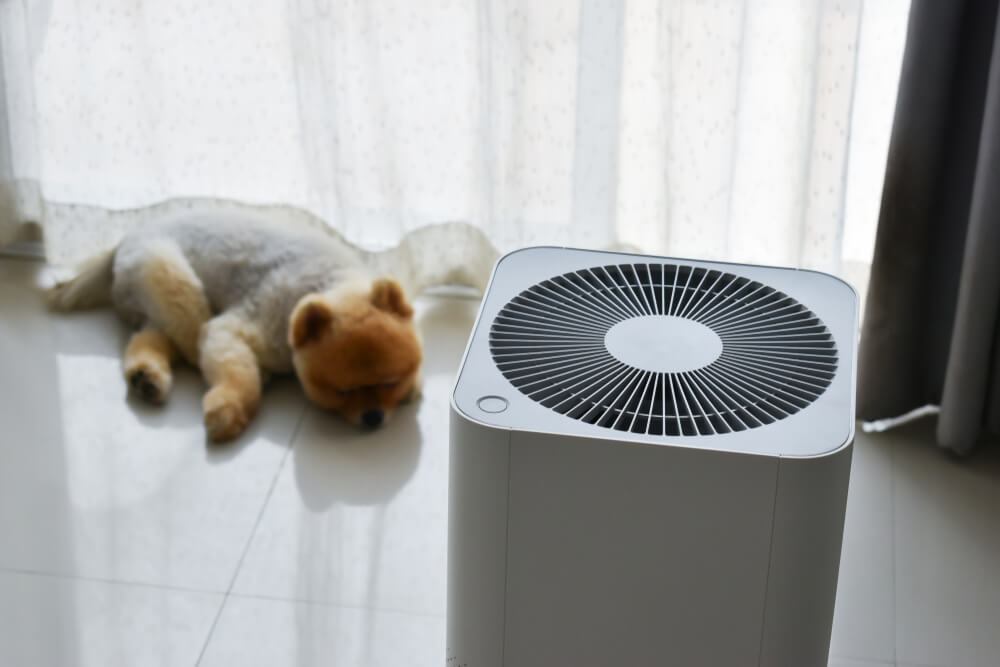
Airway and Lung Related Breathing Problems
Moving down the respiratory tract airway inflammation, pressure on the lungs, or fluid within the lungs can cause rapid breathing.
Allergic Airway Disease (Asthma)
Just like people, dogs can suffer from asthma.
Asthma varies from mild to life-threatening.
If your dog is breathing rapidly, and it seems to be asthma-related, keep your dog cool and take him into fresh, clean air.
Then seek urgent veterinary assistance.
Stiffening of the Airways
Certain breeds, such as West Highland white terriers, may suffer from stiffening of the airways as they get older.
They have consistently harsh breathing at rest and play.
Long-term medication with bronchodilators (medications that open up the airways) can slow progression.
Smoke Inhalation
Exposure to fire irritates the airways and causes fluid leakage into the lungs.
Lung Disease
Here the lung tissue itself is the source of the problem.
These problems reduce the lung’s ability to work properly.
To cope, the dog takes more breaths in order to make up the difference.
The dog will reach a point where they can no longer cope and collapse, so prompt treatment is essential.
Cancer
Primary lung cancer is rare in the dog. More common is a secondary spread from another cancer.
If you think cancer might be causing your dog’s rapid breathing, speak to your vet about treatment for this possible complication.
Parasitic Infections
Topping the list of “best avoided” are heartworm and lungworm.
These parasites migrate through the lungs, causing tissue damage, and interfere with blood circulation.
Pneumonia
A chest infection can settle on the lungs causing breathing difficulties
Has the dog been off-color recently, running a fever, or refusing to eat?
Do they have a moist cough?
The dog requires antibiotics, so visit the vet urgently.
Pulmonary Hemorrhage
Trauma can cause blood clots to form in the lungs.
If your dog has had a recent heavy fall, kick, or traffic accident, you should see your emergency veterinarian immediately.
Compressed Lungs
Sometimes the lungs are healthy, but they are compressed and unable to fill with air which leads to rapid breathing.
These conditions require emergency help. Left untreated, the dog is unlikely to recover.
However, treatment can be lifesaving and in many cases curative.
Pneumothorax
A penetrating wound, such as a dog bite, allows air to leak into the chest.
Without a vacuum around the lungs, they cannot fill with air.
Cover any obvious chest wounds to provide an air seal and then seek emergency veterinary assistance.
Pleural Effusion
More common in cats than dogs, a buildup of fluid around the lungs is called a pleural effusion.
The fluid physically squashes the lungs, preventing them from filling with air.
The commonest effusions are related to the presence of a tumor, blood, pus, or chyle.
A vet needs to image the chest to check for effusion and then drain it under aseptic conditions.
Then to avoid recurrence, the source of the fluid needs to be identified.
Diaphragmatic Hernia
If the muscle separating the tummy from the chest is ruptured, then abdominal contents enter the chest cavity and compress the lungs.
This is called a diaphragmatic hernia.
If your dog has been in a recent accident or fall, keep the dog quiet and calm.
Seek veterinary attention immediately as the diaphragm requires surgical repair.
Tachypnea
A dog breathing fast but not panting, or a dog breathing fast and shallow, is considered tachypnea.
This condition can be caused for several reasons, including a sinus infection or diseases of the larynx, trachea, bronchial tubes, or lungs.
Dogs can become tachypneic due to other conditions of the respiratory including a collapsed trachea, soft palate disorder, pleural effusions, hernias, tumors, or pneumothorax.
Non-Respiratory Tract Related
Sometimes the lungs are innocent bystanders caught up in a situation, not of their making.
Fast breathing shows the dog is struggling in some way, be it physical or psychological.
Where possible, identify and correct the issue.
Where the causes aren’t obvious or the dog fails to improve, seek urgent veterinary help.
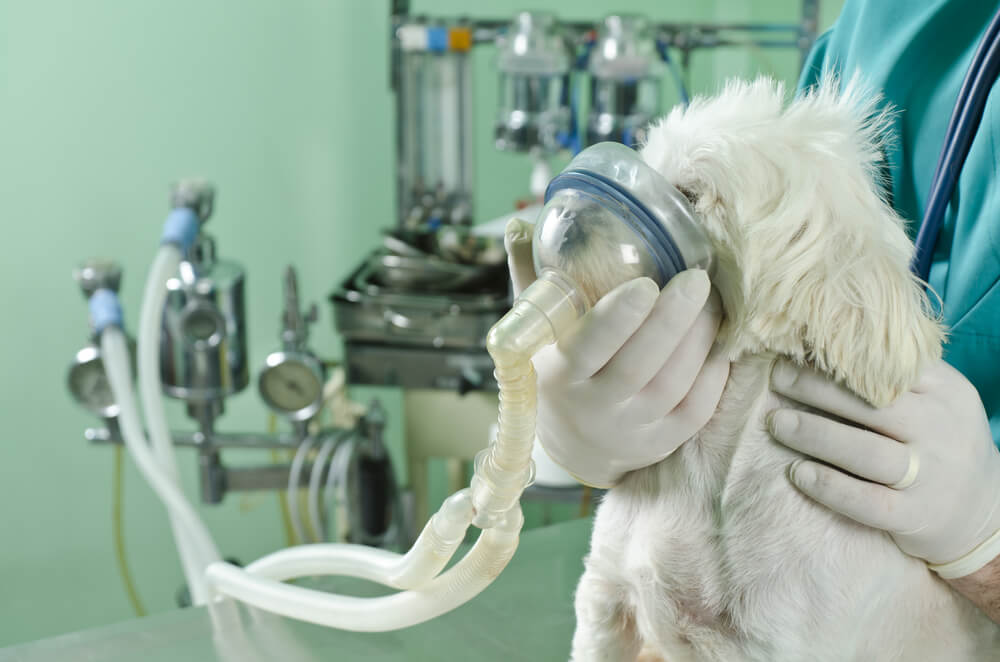
Heart and Circulation
Dog under blanket
When the heart doesn’t pump properly, fluid builds up in the lungs and hinders gas exchange.
This might be an issue if:
- The dog has a cough that gets worse at night.
- He is more tired than usual.
Heart scans can pinpoint the exact nature of the heart disease and help your vet get appropriate treatment started.
An indicator that your dog may have a heart condition is if you observe your dog breathing fast while sleeping, especially if it’s an older dog breathing fast while sleeping.
Fast breathing as well as labored, difficult breathing, signs a dog may have congestive heart failure.
If this is already a known condition for a dog, an increase in their breathing rate can mean they are getting close to their final days.
Anemia
Anemia, which is a shortage of red blood cells means a lack of oxygen-carrying capacity.
To compensate, the lungs work harder.
If your dog’s gums look pale or white, you should see your vet.
A blood transfusion may be required while the vet diagnosis the cause of the anemia.
Fever
When running a fever, a dog pants to lose heat.
If your dog’s temperature is above 103F (39.4 C) or his gums look brick red, this could be the cause of his fast breathing.
Antibiotics, drugs to lower fever, and intravenous fluids help a dog through a fever.
Heat Stroke
Dogs don’t sweat and their main way to lose heat is panting.
If you suspect heatstroke, carry the dog to a cool place, wet his paws, and offer water to drink.
If he’s collapsed or doesn’t improve in a few minutes, visit a vet urgently.
Nausea
Feelings of sickness due to illness or motion sickness will cause panting.
If the dog has a stomach upset, withhold food and offer small sips of water.
If vomiting is repeated or persists for more than four hours seek veterinary attention.
For motion sickness, the good news is there is now an excellent medication (Cerenia) available from your vet which stops nausea but doesn’t sedate the dog.
Swollen Belly
An enlarged abdomen puts pressure on the diaphragm preventing deep breaths.
This could be due to bloat or a buildup of fluid in the abdomen.
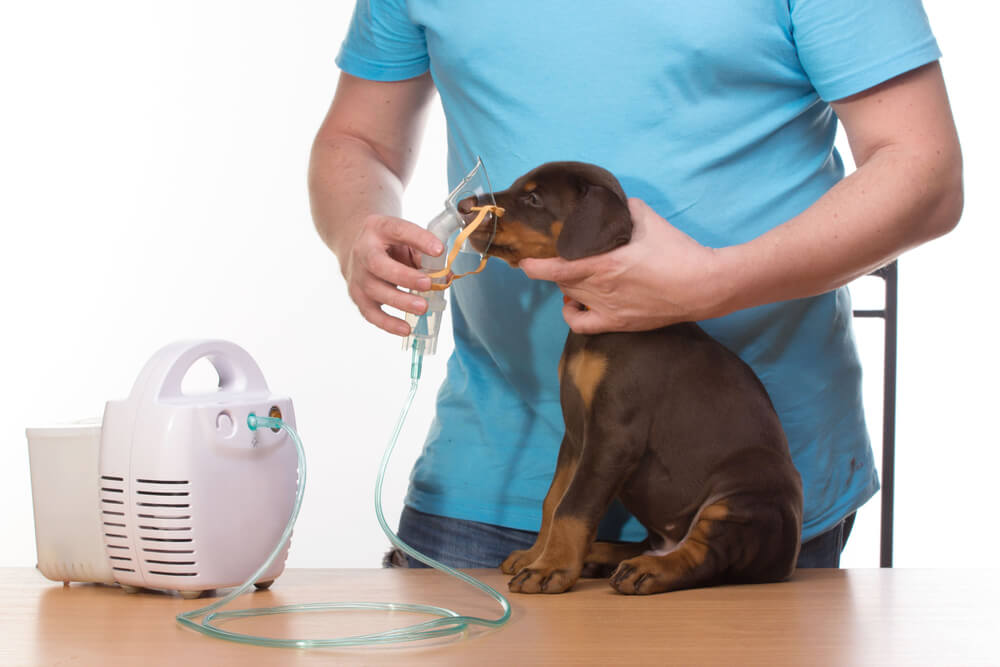
Metabolic Causes
How conditions such as diabetes or Cushing’s disease cause shifts in electrolytes which trigger panting.
- Has the dog’s eating or drinking habits changed recently?
- Do they seem off-color?
The signs are quite general and a diagnosis requires blood tests to pinpoint the problem.
Behavioral
Sometimes rapid breathing is a behavioral response and not directly related to a physical disorder.
Anxiety or Pain
When fearful or in pain, the body goes into ‘fight or flight mode and releases adrenaline and cortisol.
These put the body into a state of high arousal, ready to defend itself or run.
Is the dog showing other signs of stress such as lip licking, cowering, or avoiding eye contact?
Is the dog limping or seem in discomfort?
Canine Cognitive Disorder
Senior dogs can suffer from a condition similar to dementia in older humans.
Among the several symptoms involved, one is an increase in confusion from your dog, particularly at night.
This can make your dog more anxious and heavy breathing at night can be a result of the dog’s distress.
Medication
Observing a dog breathing fast after pain medication is common as some types of prescriptions can cause your dog’s respiratory rate to go up. Prednisone is a medication used for pain that has this effect.
Exercise
And last but not to be overlooked, during exercise panting meets the need for extra oxygen in the bloodstream.
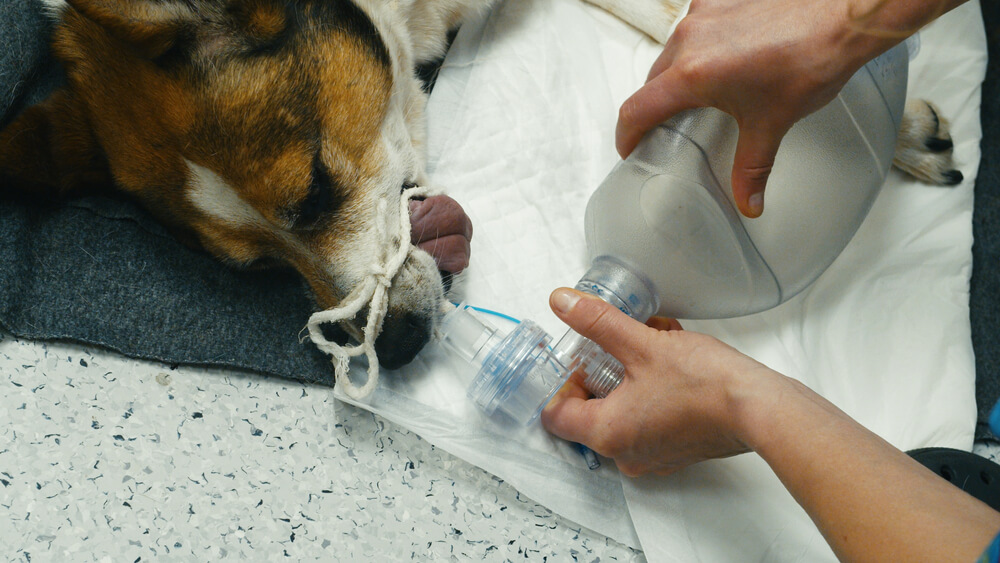
Don’t Ignore Fast Breathing
Your dog has only a few ways of telling you he’s unwell, of which rapid breathing is an important clue.
Other vital signs are pale or blue-tinged gums, lack of energy, coughing, weakness, weight loss, or altered habits.
If you want to know how to help a dog breathe better, get him to a veterinarian immediately as this is the fastest and safest way to improve your dog’s quality of life.
While it’s tempting for many pet owners to try home remedies for their dog, fast breathing is one where you should have your veterinarian examine your dog first to make sure he’s safe and he or she can discuss potential home remedies with you.
As you see from the list above, there are many reasons why a dog might pant so don’t be a home physician.
Instead, if you have a panting pooch, do them a favor and have a vet check your best buddy out.
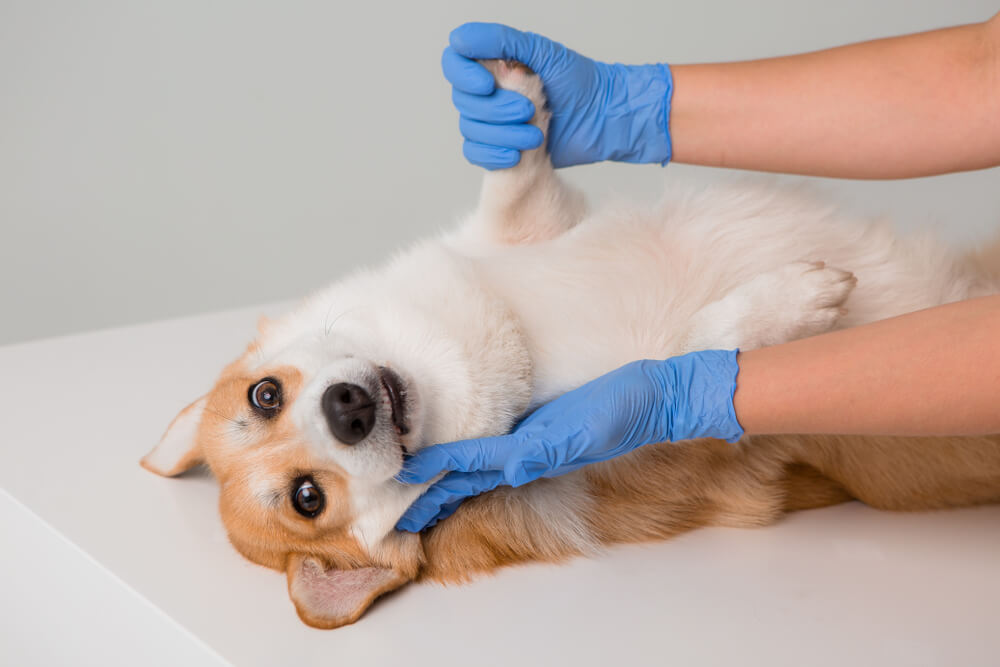
When Should I Contact My Vet About
My Dog’s Breathing?
If you notice that your dog is breathing fast while at rest, or breathing fast while sleeping, they could be experiencing respiratory distress. Contact your vet if you notice any of the following signs:
- Noticeably labored breathing
- Pale, blue-tinged, or brick red gums
- Reluctance to drink, eat or move
- Open-mouthed breathing while at rest
- Out of character drooling
- Heavy, fast breathing that’s louder or different sounding than normal panting



